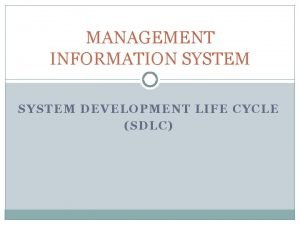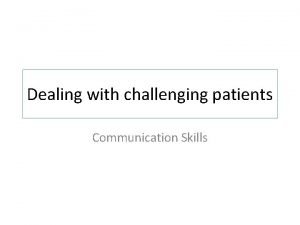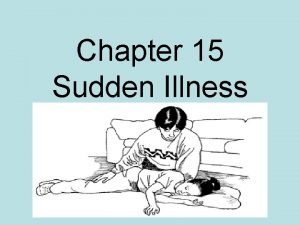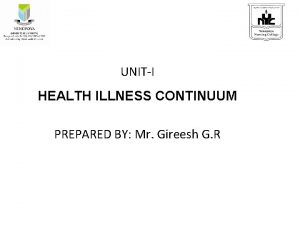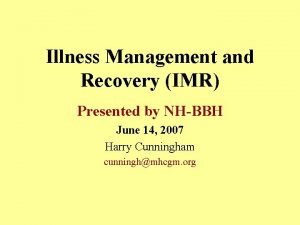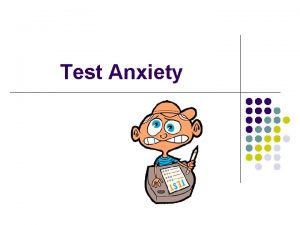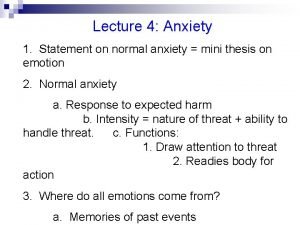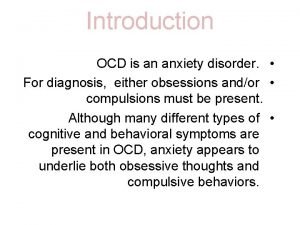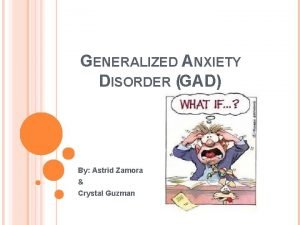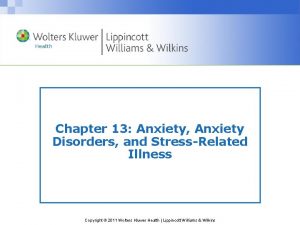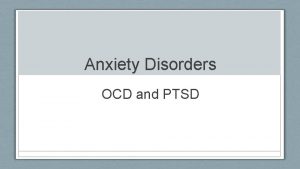Somatization and Illness Anxiety Strategic Engagement in Challenging

















































- Slides: 49

Somatization and Illness Anxiety: Strategic Engagement in Challenging Encounters 10/2018 Tom Linde, MSW Grant Scull, MD Kaiser Permanente of Washington Family Medicine Residency

Example Patients Recurrent UC Visitor Induces panic by attributing palpitations to heart failure High-strung Worrier Who’s cough interacts with globus sensation and laryngospasms Never-seen Sufferer Deathly afraid of any clinic encounter Also, chronic fatigue, neurogenic pain, chronic Lyme, Morgellon’s… 2

Learning Goals Understand processes causing somatization Expand use of three words: Ovoid common pitfalls Avoidance Interoception Expand range of meaningful, gratifying encounters Alexythymia Discuss Case 3

DSM-5 Diagnoses Somatic Symptom Disorder • Replaces somatization disorder and pain disorder • No mention of medical work-up. Symptom etiology is less relevant than Pt’s level of worry, impaired quality of life, and care utilization. Illness Anxiety Disorder • Replaces hypochondriasis • Care-seeking vs. care-avoidant Functional Neurological Symptom Disorder • Replaces conversion disorder (one step further from “hysteria”) Other • Psychological factors affecting other medical conditions • Factitious disorder • Body dysmorphic disorder 4

Higher Incidence In: Those who cannot identify and verbalize feelings Children who “talk with their bodies”: stomach aches may represent fear Groups less likely to discuss emotions and relationships 5

Somatization Cycle: Recognize and note signs and symptoms Monitor for recurrence Ponder meaning and make interpretations Feel better with attention – temporarily Worry about negative meanings Seek care and comfort Catastrophic interpretation (magnified threat assessment) Generate fear arousal Increased symptoms and vigilance 6

Cycle 2: Belief, Symptom, Behavior Stable Belief: “I shouldn’t have symptoms” → “Because I have a symptom, it’s a problem” → “This problem needs attention” → Medical attention may reinforce original belief and avoidance of discomfort 7

When Reassurance Backfires : ” r o ct ine! o D re f u’ o “Y “I’m Pa tie t h wo e w nt: An d. I ’ll w unde alkin d!” g con or k vin ha ce rd you er ! to 8

When Reassurance Works : ” r o ct ine! o D re f u’ o “Y “W he Pati w I en An d. I ’ll n feel t: be tte tom eed y r!” orr ou ow aga ! in 9

No-win experience of ineffectiveness may leave practitioner exasperated and… …avoidant of full engagement. 10

On Avoidance We must expose to a fear to overcome it. Examples: • Fleeing from spiders reinforces phobia • Bronco riders who should fear wild horses, don’t, because they always get back on • MD reassurance enables patient to avoid anxiety provoked by ambiguous symptoms • Clinicians avoiding full engagement with anxious patients increases dissatisfaction for both clinician and patient 11

Practitioner’s Dilemma Anxiety thrives on avoidance Resolution requires exposure Medical attention could support avoidance and be counter-productive Attention to this bind helps in navigating it 12

Managing Double Bind: Above all else, convey empathy and validation • Emphasize that the pain is real • Assure that the fear is reasonable - given the circumstances 13

Three More Motives for Empathy Encapsulate patient’s long report, shorten interview* When it “clicks”, with authentic connection, your work is more gratifying You are helping with… alexithymia *Attentive, empathic listening does not support Pt’s distorted narrative. 14

Alexi who? A-lexi-thymia 15

Alexi who? A-lexi-thymia The inability to identify and describe one’s own emotions 16

Alexi who? A-lexi-thymia The inability to identify and describe one’s own emotions Alternate expression may occur via altered behavior (e. g. children acting out), or 17

Alexi who? A-lexi-thymia The inability to identify and describe one’s own emotions Alternate expression may occur via altered behavior (e. g. children acting out), or the experience and report of symptoms (somatization) 18

Extra Empathic Reflection Amplify Patient’s Dramatic Verbiage: • “It feels like getting stabbed with a knife” • “Like a rusty knife, I imagine” Reflect Impact: • “You must be preoccupied all the time. This must affect _____ (Patient’s value)” Suggest Levels of Emotion Patient is not Articulating: • “It’s more than just uncomfortable, right? Unsettling, possibly? Scary…? ” (Reduce alexithymia) Tip: Practice naming your own emotions 19

Validate & Expand Pt’s Experience Verbal Expression Emotional Distress Physical Discomfort 20

More Strategies Invite spouse/partner to appointments To increase data and to reinforce your message 21

More Strategies Inquire about adherence to plan! Otherwise, you signal that prior recommendations were not important Lack of follow-up inquiry promotes non-adherence 22

More Strategies Consider regular schedule of return visits –contingent on calendar, not on symptoms 23

Or put another way, When certain names on your schedule make your head hurt perhaps you will benefit from an exposure and desensitization schedule! 24

Clinical Alliance Check on patient’s experience of alliance: • “How are we doing; you and I? ” • “Does it feel like I fully understand you? Responding OK? ” 25

Introduce Concepts via New Words Iatrogenic Idiopathic Anhedonia Interoception 26

Interoception The sense of the physiological condition of the body: e. g. hunger, gas, itching, palpitations. 27

Interoception The sense of the physiological condition of the body: e. g. hunger, gas, itching, palpitations. Noise (benign sensation) may be confused with signal (important warning). 28

Brief Interoceptive Exposure Feared Sensation Technique SOB, tingling, dizziness Hyperventilation SOB, racing heart, sweating, flushing Run in place Dizziness, disorientation Spin while standing or in revolving chair Globus sensation (throat constriction) Swallow rapidly 5 times Pain Hold hand in ice water or hold weight at arms length *Do not reassure patient. The point is to experience benign outcome in face of catastrophic expectation. 29

Rx Considerations Consider starting at low dose 30

Rx Considerations Consider starting at low dose Promise side effects. Be vague. Emphasize tradeoff 31

Rx Considerations Consider starting at low dose Promise side effects. Be vague. Emphasize tradeoff “Side effects mean the Rx is working. ” 32

Rx Considerations Consider starting at low dose Promise side effects. Be vague. Emphasize tradeoff “Side effects mean the Rx is working. ” Warn about passive reliance: “Rx helps those who help themselves. ” 33

Rx Considerations Consider starting at low dose Promise side effects. Be vague. Emphasize tradeoff “Side effects mean the Rx is working. ” Warn about passive reliance: “Rx helps those who help themselves. ” At first sign of improvement: “What else are you doing? It’s never just the Rx!” 34

More Strategies Keep checking on: Ask (again!) about alcohol and drugs • Activities • Health practices • support Check on violence/abuse – esp. current 35

Framing Reassurance Avoid repeated reassurances. Invite patient to recall your previous explanation or to predict your upcoming one. 36

Framing Reassurance Avoid repeated reassurances. Invite patient to recall your previous explanation or to predict your upcoming one. With skeptical Pt, consider, “I’m worried my house is on fire. Can you reassure me it isn’t? ” 37

Framing Reassurance The patient will interpret, it’s all in your head, and will report to friends, my doc says I’m making it up. Actively counteract: • “Your pain is absolutely real. Your worry is legitimate”. “Our job is to carefully rule out the possible diagnoses, and we will… • “Your job is to delegate. ” 38

Symptom Diary “Log” may be more palatable. Include: Time Symptom intensity/duration Emotion Activity Medication Consider: sleep, alcohol, physical therapy, relaxation practice, etc. Explain: “We all modify what we track, and you and I will make good use of the information you collect”. 39

Expand Pt’s Treatment Goals Ask not “How are you doing? ” Rather, “What have you been doing? ” Quality of life: Increased activity Expanded support Accept discomfort and uncertainty And alleviate symptoms 40

Expand Relationship &Discussion “What do you want your life to be about, rather than this? ” “If this resolved 100% while sleeping tonight, what would you see yourself doing differently tomorrow? ” “When this starts to get better, what is the first change others will notice? ” Be aware of the effect of chitchat. Is this a social visit for your patient, or are you reinforcing what is meaningful? 41

Conclusion Expanding - Pt’s understanding of anxiety 42

Conclusion Expanding Pt’s Treatment Goals Pt’s understanding of anxiety 43

Conclusion Expanding Pt’s Treatment Goals Your empathic vocabulary Pt’s understanding of anxiety 44

Conclusion Expanding Pt’s Treatment Goals Your empathic vocabulary Your knowledge of Whole Patient Pt’s understanding of anxiety 45

Conclusion Expanding Pt’s Treatment Goals Your empathic vocabulary Your knowledge of Whole Patient Pt’s understanding of anxiety - May help with entrenched dynamic and with satisfaction for both patient and clinician 46

tomlinde. com > Training Materials Crib Notes EMR text, e. g. And more • This presentation on two pages • Illness Anxiety literature for patients • 10 ways to activate from depression • This slide show • Shrink Rap: Psych concepts for physicians 47

Grant’s Case • LB, 76 y/o female, still working as the office manager of a King County Land Use program in Downtown Seattle. She lives alone in her own home, has generally quite good health. She is intelligent, articulate, and very anxious about her health, particularly chronic sinusitis, hiatal hernia, breast cancer. I have cared for her since 2009 and feel we have an excellent patientprovider relationship. - She has a regimen of nasal irrigation, sinus steaming, decongestants, nasal steroids that she performs daily. - She monitors her temperature multiple times a day, and becomes highly alarmed if there is a variation from morning to evening in her temperature. - Despite serial consults with Otolaryngologists and serial CT sinus scans that do not show sinusitis, she persists in her conviction that she suffers recurrent sinusitis. - She has had 17 visits with me in the last 12 months, either phone or office, to address these concerns. - She does yearly mammograms and specifically schedules an office visit with me for the day after the mammogram to receive the report in person, dreading the news each time. - She is charming, pleasant, recognizes her “neuroses”, and is highly receptive of my assessments and reassurances. 48

Group Task • How might this case go poorly? • How might it go well? • Describe application of tools reviewed here. 49
 Somatization disorder dsm 5
Somatization disorder dsm 5 Conversion vs somatic symptom disorder
Conversion vs somatic symptom disorder Somatoform disorder
Somatoform disorder Somatoform disorder nursing diagnosis
Somatoform disorder nursing diagnosis Somatoform disorders
Somatoform disorders 8 stages of sdlc
8 stages of sdlc Feasibility study in sdlc
Feasibility study in sdlc What i found challenging
What i found challenging Trust star worksheet examples
Trust star worksheet examples Challenging resistance to change
Challenging resistance to change Challenging behaviour scenarios
Challenging behaviour scenarios Challenging text examples
Challenging text examples Exciting, boring, dangerous, safe, interesting, challenging
Exciting, boring, dangerous, safe, interesting, challenging Time intensity model reactive strategies
Time intensity model reactive strategies Children challenging industry
Children challenging industry Difference between loose and periodic sentence
Difference between loose and periodic sentence Dealing with challenging patients
Dealing with challenging patients Strategic complements
Strategic complements Io model strategic management
Io model strategic management Strategy analysis and choice largely involves making
Strategy analysis and choice largely involves making Strategic fit vs strategic intent
Strategic fit vs strategic intent Chapter 8 managing stress and anxiety
Chapter 8 managing stress and anxiety Frustration anxiety and tension
Frustration anxiety and tension Chapter 15 anxiety and obsessive-compulsive disorders
Chapter 15 anxiety and obsessive-compulsive disorders Chapter 5 lesson 1 dealing with anxiety and depression
Chapter 5 lesson 1 dealing with anxiety and depression Chapter 5 lesson 1 dealing with anxiety and depression
Chapter 5 lesson 1 dealing with anxiety and depression Cpi verbal escalation continuum
Cpi verbal escalation continuum Anxiety symptoms
Anxiety symptoms Mental health and mental illness chapter 20
Mental health and mental illness chapter 20 Sudden illness examples
Sudden illness examples Health illness continuum
Health illness continuum Illness and wellness continuum
Illness and wellness continuum Eudemonistic model
Eudemonistic model Illness management and recovery worksheet
Illness management and recovery worksheet How anxiety affects eyewitness testimony
How anxiety affects eyewitness testimony Relaxation techniques test anxiety
Relaxation techniques test anxiety Test taking anxiety symptoms
Test taking anxiety symptoms I'm a perfect example of someone who has math anxiety
I'm a perfect example of someone who has math anxiety Neurotic anxiety example
Neurotic anxiety example Anxiety mnemonic
Anxiety mnemonic Powerlessness nursing care plan
Powerlessness nursing care plan Examples of generalized anxiety disorder
Examples of generalized anxiety disorder Free floating anxiety
Free floating anxiety Ocd vs gad
Ocd vs gad Uw integrative medicine
Uw integrative medicine Examples of generalized anxiety disorder
Examples of generalized anxiety disorder Sharat chandran
Sharat chandran Generalized anxiety disorder dsm 5
Generalized anxiety disorder dsm 5 Neurotic anxiety example
Neurotic anxiety example Neurotic anxiety example
Neurotic anxiety example






